In this article, You will read Horticulture in India – for UPSC.
Horticulture
- Horticulture is a branch of agriculture relating to the cultivation of fruits, vegetables and ornamental plants.
- Horticulture is a capital and labor intensive agriculture.
- India is bestowed with varied agro-climates, which is highly favorable for growing large number of horticultural crops such as fruits, vegetables, spices, root tuber, ornamental, aromatic plants, medicinal species and plantation crops like coconut, arecanut, cashew and cocoa..
- Presently, horticulture crops occupy about 10 per cent of the gross cropped area of the country, producing about 160 million tones. India is the second largest producer of fruits and vegetables.
- The total production of fruits has been estimated at about 63 million tons from 5.7 million hectares. Vegetables occupy an area of 7.8 million hectares with a production of 125 million tons (India 2009).
- India’s share in world fruit and vegetable production is 12.6 per cent and about 14.0 per cent respectively.
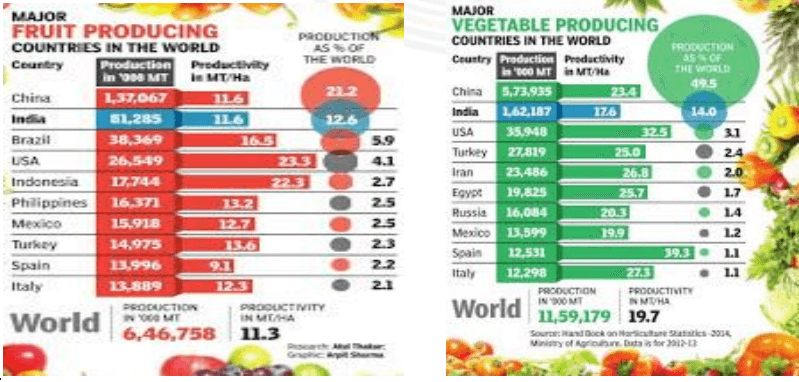
Fruits
- Indian climate favors the development of a large range of varieties of fruits.
- Indians share in the total fruit production of the world is 10 per cent.
- Mango, banana, citrus, pineapple, papaya, guava, sapota (cheekoo), jackfruit, litchi, and grapes, among the tropical and subtropical fruits; apple, pear, peach, plum, apricot, almond, walnut, among the temperate fruits; and aonla, ber, pomegranate, fig, phalsa, among the arid fruits are important.
- India’s top produced fruit is Banana (32%), followed by Mango (21%). On the other hand, Mango is cultivated on largest area in comparison to any other fruit. Top cultivator state of Banana is Tamil Nadu; and of Mango are Uttar Pradesh (24.4%) and Andhra Pradesh (24.5%).
- India leads the world in the production of mango, banana and nimboo (arid lime), and in productivity of grapes per unit land area.
- About 10 per cent of world’s mango and 23 per cent of world’s banana are produced in the country.
- In grapes, India has recorded the highest productivity per unit area in the world.
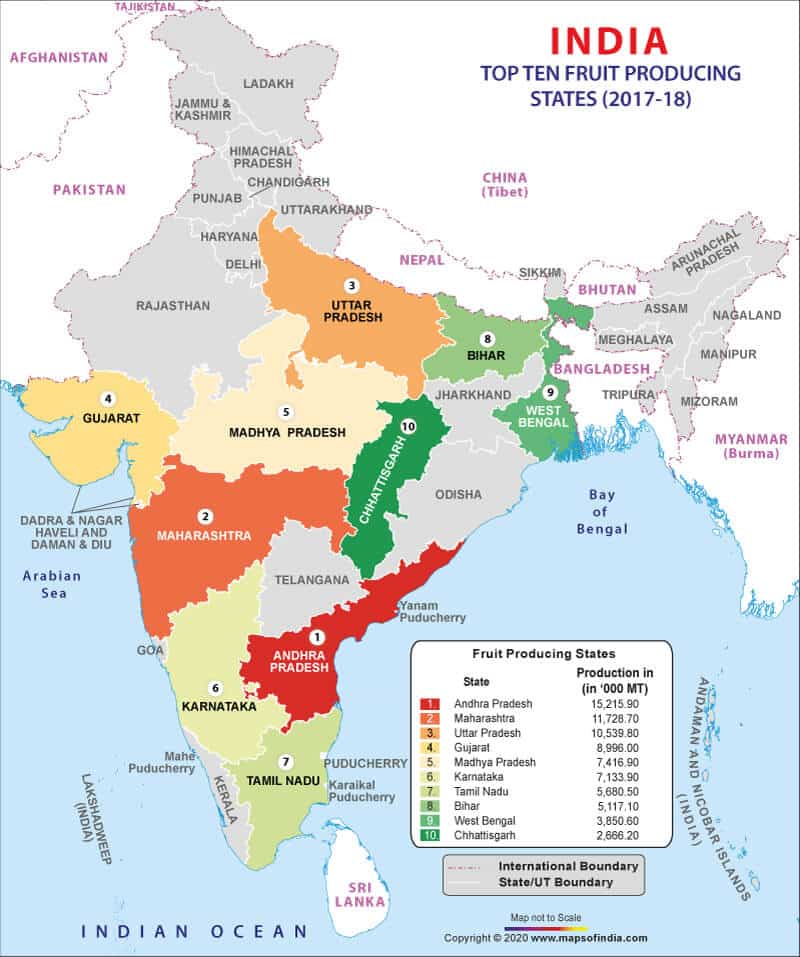
Vegetables
- More than 40 kinds of vegetables are grown in India.
- Important vegetable crops grown in the country are potato, tomato, onion, chilies, carrot, radish, turnip, beans, lady finger, guard, letuce, brinjal, cabbage, cauliflower, spinach, okra, and peas.
- India’s largest produced vegetables are Potato, followed by Tomato. Among vegetables, largest area under cultivation is that of Potato.
- India is next only to China in area and production of vegetables, and occupies the first position in the production of cauliflower, second in onion, and third in cabbage in the world.
- The area and production of major vegetables during 2004-05 is estimated at 6.30 million hectares with a production 01.93 million tones and average productivity of 11.8 tons per hectare.
- During 2016-17, total vegetable production was highest in case of Uttar Pradesh (26.4 million tons) followed by West Bengal (25.5 million tons).
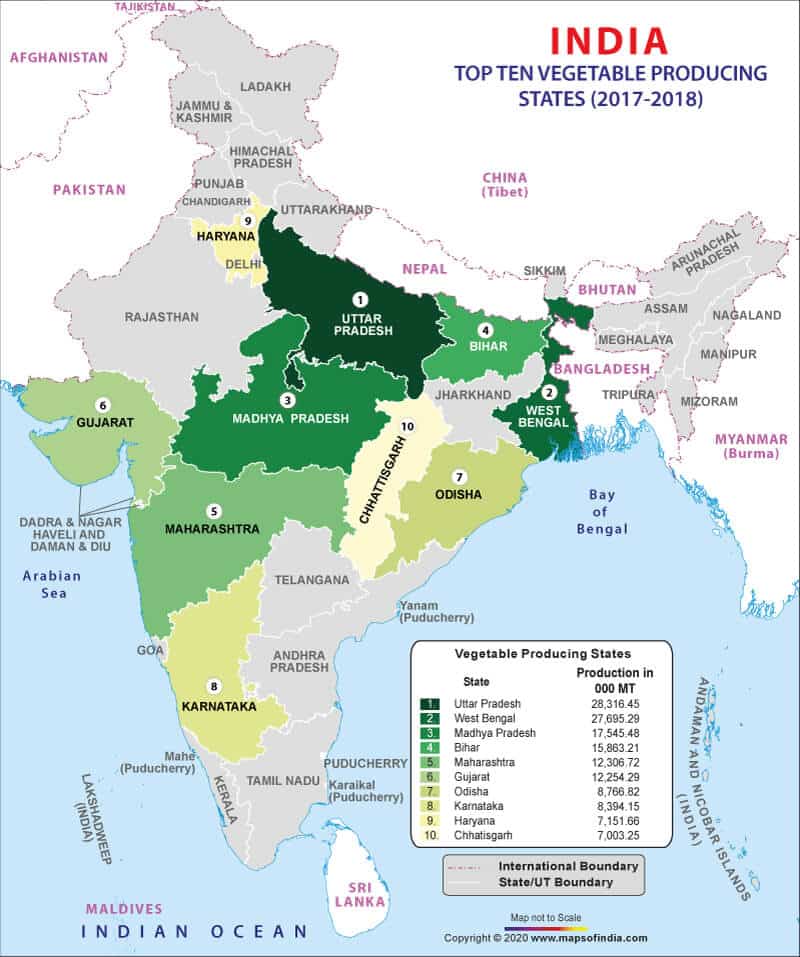
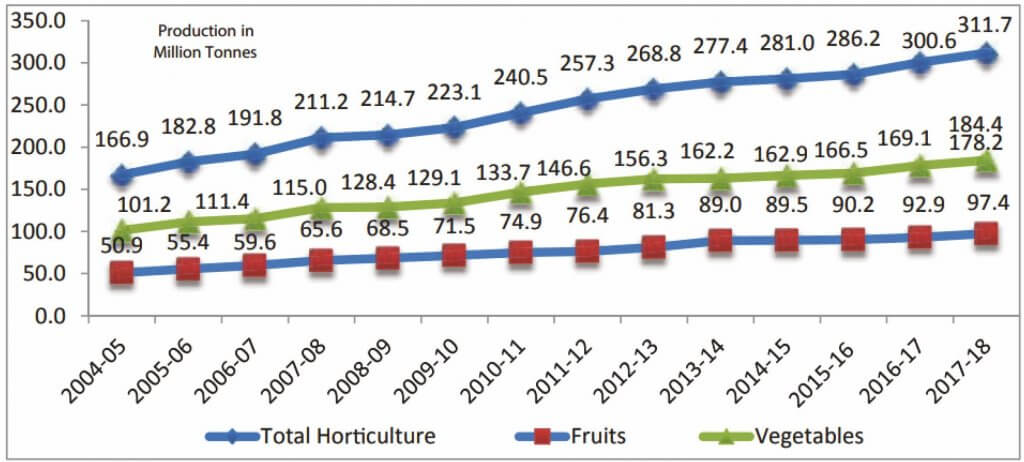
Flowers
- The increased growing of contemporary cut flowers like rose, gladiolus, tuberose, carnation, etc. has led their use for bouquets and arrangements for gifts, as well as decoration of both home and workplace.
- A growing market, as a result of improvement in the general level of well – being in the country and increased affluence, particularly among the upper and middle classes, has led to transformation of the activity of flower growing into a well developed industry.
- Availability of diverse agro-climatic conditions in the large country facilitates production of all major flowers throughout the year in some part or the other and improved transportation facilities have increased the availability of flowers all over the country.
- India has made noticeable advancement in the production of flower. Floriculture is estimated to cover an area of 1.14 lakh hectares with a production of 670,000 million tones of loose flowers and 13,010 million tones of cut flowers.
- In terms of flowers production Tamil Nadu has the highest share of production of flowers (loose flowers).
- A major programme, namely National Horticulture Mission (NHM) was launched in the country during the Tenth Five Year Plan with effect from 2005 – 06. The main objectives of the Mission are to enhance horticulture production through area based regionally differentiated strategies to improve nutritional security and income support to farm households, and to promote and disseminate technologies.
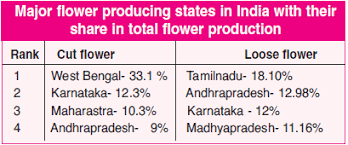

Horticulture in India
- Horticulture is the cultivation of garden plants, fruits, berries, nuts, vegetables, flowers, trees, shrubs and turf. Horticulturists work for plant propagation, crop production, plant breeding, genetic engineering, plant biochemistry, plant physiology, storage, processing and transportation.
- Horticulturalists use modern nurseries for the production of seedlings and mother plants. These plants are propagated through different methods such as seeds, inarching, budding, veneer grafting, patch budding and soft wood grafting.
- Tamil Nadu – This State is suitable for horticulture because of its rich bio diversity and appropriate climate. A wide variety of tropical fruits, temperate fruits, vegetables, spices, condirnents, plantation crops, medicinal herbs, aromatic plants and commercial flowers are grown here.
- Jammu and Kashmir – The horticulture industry is the mainstay of the rural economy of Kashmir. Every year, this industry earns revenue of over Rs. 50 crores. Fruits cultivated in Kashmir include a variety of apple, pears, cherries, walnuts, almonds, peaches, saffron, apricots, strawberries and plums.
- Odisha – Here horticulture consists of the cultivation of fruits like pineapple, mango and cashew, vegetables like mushroom, drumstick, and onions; and spices like ginger and turmeric. Strategies by the State Government for the promotion of horticulture include supplying better quality planting material at subsidized rates, conducting training programmers; field demonstrations and encouraging cultivation at lift irrigation points.
- Punjab – Around 1, 82,600 hectares of land were brought under horticulture crops till 2002. This area has grown a lot since then. Currently, fruits like sweet orange, kinnow, guava, peace, litchi and mango are grown in the region.
- Maharashtra – Horticulture involves the cultivation of fruits like banana, fig, grapes, custard apple, wood apple, jhambul, pomegranate, mandarin orange, guava and sweet orange. Vegetables, medicinal plants and spices are also grown in the state.
- Tripura – It the land of high hills and hillocks interspersed with rivers and valleys. It has moderately warm and humid climate coupled with well – distributed annual rainfall of 2500 mm. This terrain and climate is ideally suited for rainfed horticulture. Fruits like pineapple, jackfruit, orange, litchi, cashew nut, coconut, lime and lemon are produced in abundance.
- Assam – Some of the popular horticulture crops grown in Assam are carambola, wood apple, jackfruit, ginger, oranges, olives, figs and bamboo shoot. Almost 75 per cent of the population of the state derives their livelihood from agriculture and horticulture.
- Andhra Pradesh – This State has a varied climate and is suitable for a wide range of horticultural crops. It leads in the production of citrus, chillies, turmeric and oil palm. Andhra Pradesh is also a major producer of cocoa, cashew, guava, coriander, banana, ginger and coconut.
Horticultural Sector in India: Retrospect and Prospect
- Horticulture has become a key driver for economic development in many of the state in the country and it contributes 30.4 per cent to GDP of agriculture.
- Horticultural crops play a unique role in India’s economy by improving the income of the rural people.
- Cultivation of these crops is labor intensive and as such they generate lot of employment opportunities for the rural population.
- Fruits and vegetables are rich source of vitamins, minerals, protein, and carbohydrates etc. which are essential in human nutrition. Thus, cultivation of horticultural crops plays a vital role in the prosperity of a nation and is directly linked with the health and happiness of the people.
- Globally, India is the second largest producer of fruits and vegetables. It is the largest producer of mango, banana, coconut, cashew, papaya, pomegranate etc, in the world and the largest producer and exporter of spices.
- It ranks first in productivity of grapes, banana, cashew, peas, papaya etc., and the export growth of fresh fruits and vegetables in term of value is 13 per cent and of processed fruits and vegetables is 17.42 per cent in 2011-12.
- The focused attention on horticulture has paid dividend and resulted in increased production and export. The production of horticultural produce has increased 7 – fold which ensured nutritional security and employment opportunities in the country.
- The total horticulture production has increased from 211.2 million tonnes in 2007-08 to 28.17 million tonnes in 2017-18.

Horticulture Vs Agriculture
- Horticulture primarily differs from agriculture in two ways.
- First, it generally encompasses a smaller scale of cultivation, using small plots of mixed crops rather than large fields of single crops.
- Secondly, horticultural cultivations generally include a wide variety of crops, even including fruit trees with ground crops.
- Horticulture sector has marked higher growth as compared to agriculture sector in India from 2012-13 to 2017-18.
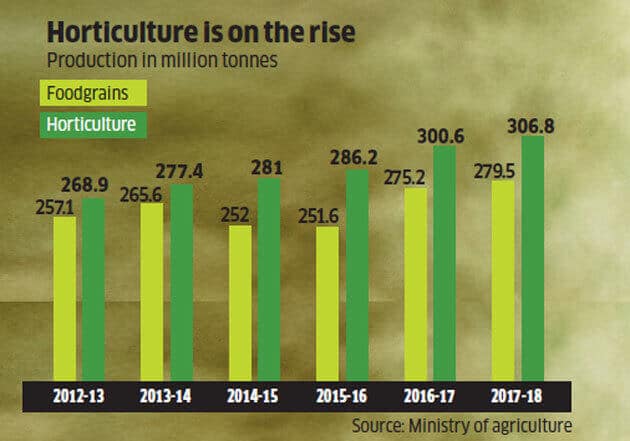
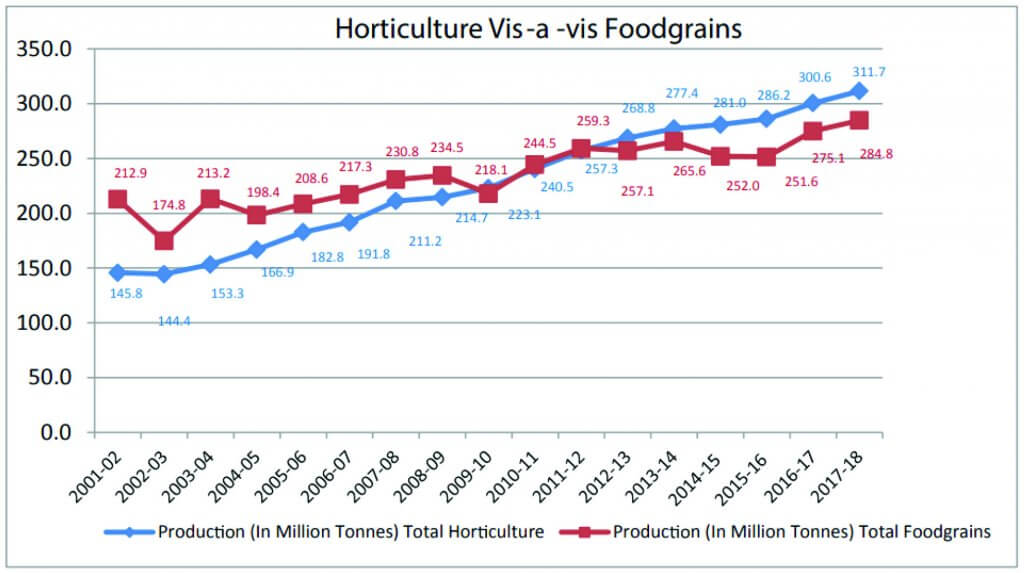
Importance and Scope of Horticulture in India
- India with more than 68 million tones of fruits and 121 million tones of vegetables in 2011-12 is the second largest producer of fruits and vegetables in the world, next only to China.
- However, per capita consumption of fruits and vegetables in India is only around 46 gram and 130 grams respectively against a minimum of about 92 gram and 300 gram respectively recommended by Indian Council of Medical Research and National Institute of Nutrition.
- With the present level of population, the annual requirement of fruits and vegetables will be of the order of 110 million tons and 360 million tons respectively (Karunakaran and Palanisami, 2012).
- It is estimated that India has 12.66 million hectares of cultivable wasteland as on 2011- 12, which is lying idle, which can be brought under orchard crops without curtailing the area under food crops.
- The country has abundant sunshine throughout year, surplus labor and widely varied agro – climatic regions, which offer high potential for successful and profitable commercial horticulture. The major crops in case of fruits are mango, banana, citrus, apple, pineapple and in case of vegetables are potato, onion, tomato and other seasonal vegetables.
Midh (Mission for Integrated Development of Horticulture)
- It is a centrally sponsored scheme that has been launched for the holistic development of horticulture in the country’s XII plan.
- The scheme, which has taken off from 2014-15, integrates the ongoing schemes of National Horticulture Mission, Horticulture Mission for North East & Himalayan States, National Bamboo Mission, National Horticulture Board, Coconut Development Board and Central Institute for Horticulture, Nagaland.

- MIDH will have the following sub-schemes and area of operation:

Objectives
- Main objectives of the Mission are:
- Promote holistic growth of horticulture sector, including bamboo and coconut through area based regionally differentiated strategies, which includes research, technology promotion, extension, post harvest management, processing and marketing, in consonance with comparative advantage of each state/region and its diverse agro-climatic features.
- Encourage aggregation of farmers into farmer groups like FIGs/FPOs and FPCs to bring economy of scale and scope.
- Enhance horticulture production, augment farmer’s income and strengthen nutritional security.
- Improve productivity by way of quality germplasm, planting material and water use efficiency through Micro Irrigation.
- Support skill development and create employment generation opportunities for rural youth in horticulture and post harvest management, especially in the cold chain sector.
Strategy
- To achieve above objectives, the mission will adopt the following strategies:
- Adopt an end-to-end holistic approach covering pre-production, production, post harvest management, processing and marketing to assure appropriate returns to growers/producers.
- Promote R & D technologies for cultivation, production, post-harvest management and processing with special focus on cold chain infrastructure for extending the shelf life of perishables.
- Improve productivity by way of quality through:
- Diversification, from traditional crops to plantation, orchards, vineyards, flowers, vegetables gardens and bamboo plantations.
- Extension of appropriate technology to farmers for high-tech horticulture including protected cultivation and precision farming.
- Increase of acreage of orchards and plantation crop including bamboo and coconut, particularly in states where total area under horticulture is less than 50% of agricultural area.
- Improve post harvest management, processing for value addition and marketing infrastructure.
- Adopt a coordinated approach and promote partnership, convergence and synergy among R & D, processing and marketing agencies in public as well as private sectors, at the national, regional, state and sub-state levels.
- Promote FPOs and their tie up with Market Aggregators (MAs) and Financial Institutions (FIs) to support and adequate returns to farmers.
- Support capacity-building and Human Resource Development at all levels, including, change in syllabus and curriculum of graduation courses at Colleges, Universities, Polytechnics as appropriate.
Mission Interventions
- The Mission will be demand and need based in each segment. Technology will play an important role in different interventions. Technologies such as Information Communication Technology (ICT), Remote Sensing and Geographic Information System will be widely used for planning and monitoring purposes including identification of site for creating infrastructure facilities for post harvest management, markets and production forecasts.
- The interventions envisaged for achieving desired goals would be varied and regionally differentiated with focus on potential crops to be developed in clusters by deploying modern and hi-tech interventions, duly ensuring backward and forward linkage.
Key Features of Midh
- Base line survey
- Involvement of PRI
- Area based Annual and Perspective Plans
- Applied Research with focus on Region (HMNEH) and crop
- Demand driven production based on cluster approach
- Availability of quality seeds and planting material.
- Technology driven programs to improve productivity and quality, e.g.
- Introduction of improved varieties.
- Rejuvenation with improve cultivars.
- High Density Plantation.
- Use of Plastics.
- Bee-keeping for crop pollination
- Capacity building of farmers and personal.
- Mechanization.
- Demonstration of latest technologies.
- Post Harvest Management and cold chain storage.
- Marketing infrastructure development.
- Harnessing the capacities of FIGs/FPCs/FPOs
- Data base generation, compilation and analysis.
- Technical Support by NLAs.
- Production & Distribution of Planting Material Nurseries:
- Production and distribution of good quality seeds and planting material will receive top priority.
- States will have a network of nurseries for producing planting material, which were established through Central or State assistance.
- To meet the requirement of planting material (for bringing additional area under improved varieties of horticultural crops and for rejuvenation program for old/senile plantations), assistance will be provided for setting up new hi-tech nurseries and small nurseries under the public as well as private sector.
- Import of planting material
- With a view to procuring best quality planting material of latest varieties of horticultural crops, a component of providing assistance for meeting cost of planting material imported from abroad has been included.
- Area expansion will be done in conjunction with Mahatma Gandhi National Rural Employment Guarantee Scheme (MGNREGS) under which cost on labor component of work such as digging, fencing etc could be met with.
- Rejuvenation / Replacement of senile plantations / canopy management
- Rejuvenation program will address orchards and plantations which have low productivity.
- It will be implemented through individual farmers, farmer’s cooperatives, Self-Help Groups, growers’ associations and commodity organizations.
- Creation of Water Sources
- Under the Mission, assistance will be provided for creating water sources through construction of community tanks, farm ponds/reservoirs with plastic / RCC lining to ensure life saving irrigation to horticulture crops.
- This will be in conjunction with MNREGS and wherever possible adequate convergence has to be ensured. These water bodies may be linked with Micro Irrigation facility for judicious use of water.
- Protected Cultivation
- Activities like construction of green houses, shade net house, plastic mulching, and plastic tunnels, anti bird/hail nets would be promoted under the Mission.
- NHB will implement projects having area above 2500 sq. m.
- Provision has been made for selecting a variety of construction material for green houses and shade net houses.
- The cost is inclusive of irrigation systems. Preference will be given to using locally available material to minimize cost of construction of such structures. However, for availing/ subsidy assistance, all material/technologies should conform to BIS standards.
- Precision Farming Development and Extension through PFDCs
- Existing Precision Farming Development Centers (PFDC) will be involved to develop regionally differentiated technologies for their validation and dissemination.
- Twenty two PFDCs are anchored in SAUs, ICAR Institute and IIT, Kharagpur. On account of their experience in conducting applied research on plasticulture application, they have expertise in terms of manpower and equipment.
- PFDCs will be equipped with necessary hardware and software needed for generating information on precision farming techniques on the farmers’ field.
- The ultimate goal is to provide requisite information to farmers so that they are in a position to apply necessary inputs. Other organizations like ICAR Institutes and Institutes in Private sector will also be involved in technology development. For this purpose financial assistance would be provided to PFDCs.
- Promotion of Integrated Nutrient Management (INM) and Integrated Pest Management (IPM)
- Assistance for Integrated Nutrient Management (INM) and Integrated Pest Management (IPM) measures will be provided for horticultural crops as well as bamboo.
- Assistance will also be available for developing facilities like Disease Forecasting Units (DFUs), Bio control Labs, Plant Health Clinics and Leaf/Tissue Analysis labs, both under public and private sector except for DFUs, which will be only in public sector. It will be the responsibility of the beneficiary to get the bio control agents registered for commercial sale.
- Under INM component, subsidy can be availed for use of liquid biofertilizer of N, P and K such as Rizobium/Azospirillum/Azotobactor, Phosphate Solubilising Bacteria (PSB) and Potash Mobilizing Bactaria(KMB), to be applied in combination, in demonstration and other program, for which total assistance will be limited to the 50% of cost, or Rs 300.00 per ha, for maximum area of four hectare per beneficiary.
- Organic Farming
- Organic farming in horticulture will be promoted to harness environmental and economic benefits by way of adoption of organic farming techniques along with its certification.
- For adopting organic farming for perennial and non perennial food crops, vegetables, aromatic plants spices etc additional assistance will be given @50% of cost over and above the area expansion program for a maximum area of 4 ha per beneficiary, spread over the period of three years.
- Tissue Culture Unit
- New Tissue Culture (TC) units will be established and assistance will be provided for rehabilitation/strengthening of existing TC Units.
- New TC units will produce 25 lakh plants of the mandated crop for which protocols are available for commercial use, except Date palm.
- Program on horticulture and bamboo R & D
- The Program on horticulture and bamboo R & D will be based on applied research in the areas of:
- Seed & Planting material, including import of planting material,
- Technology standardization.
- Technology acquisition.
- Imparting training & Front Line Demonstration in a project mode.
- The Program on horticulture and bamboo R & D will be based on applied research in the areas of:
- Production and Productivity Improvement
- The Mission will focus primarily on increasing both production and productivity through adoption of improved and appropriate technologies for ensuring quality, including genetic up gradation of all horticultural crops and addressing challenges of climate change.
- Special emphasis will also be given for adoption of area based cluster approach towards developing regionally differentiated crops, which are agro-climatically most suitable for the State/region. Cluster approach will also help in aggregation of farmers into FPOs/FPCs.
- Good Agriculture Practices (GAP)
- GAP certification has been introduced to encourage farmers to adopt good agricultural practices in line with global GAP, so that farmers are able to get better price for their produce in domestic as well as international market.
- Centre of Excellence for Horticulture
- Centers of Excellence may be established for different horticultural products which will serve as demonstration and training centers as well as source of planting material and vegetable seedlings under protected cultivation.
- Human Resource Development (HRD) in horticulture
- Under HRD program training of farmers, entrepreneurs, field level workers and officers will be taken up.
- Program for providing appropriate training to farmers for adoption of high yielding varieties of crops and farming system will be taken up state level and outside the state
- Pollination support through bee-keeping
- In order to maximize agricultural production, honey-bee can be used as an important input. The responsibility of coordinating the bee keeping development program in state will be vested in the identified state designated agency (SDA) or any institution/society having capability.
- Nation Bee Board (NBB) will be responsible for coordinating bee keeping activity in states.
- Horticulture mechanization
- Horticulture mechanization is aimed to improve farm efficiency and reduce drudgery of farm work force.
- Assistance in this regard will be provided for activities such as procurement of power operated machines and tools, besides import of new machines.
- Technology dissemination through demonstrations/ front line demonstrations.
- Latest technologies will be promoted on crop specific cultivation, use of IPM/INM, protected cultivation, organic farming through farmer participatory demonstration in a compact area of one ha, which will be organized at strategic locations in farmer’s field for which assistance will be limited to 75% of cost.
- Integrated post harvest management
- Under post-harvest management including that for medicinal plants, activities like handling, grading, pre-conditioning, packaging, transient storage, transportation, distribution, queuing and repining and where possible long term storage can be taken up.
- Exiting schemes of the Directorate of Marketing and Inspection (DMI) and National Cooperative Development Corporation (NCDC) will be leveraged to the extent possible.
- MIDH would include projects relating to establishment of pre-cooling units “on – farms” pack houses, mobile pre-cooling units staging cold room, cold storage units with and without controlled atmosphere capability, integrated cold chain system, supply of refrigerated vans, refrigerated containers, primary/mobiles processing units, ripening chambers, evaporative/low energy cool chambers preservation units, onion storage units and zero energy cool chambers.
- Cold Chain Infrastructure
- Assistance for setting up of new cold storage infrastructure will available only to multi-chamber cold storage units with technologies which are energy efficient with provision for thermal insulation, humidity control, advanced cooling system, automation, etc. having specifications and standards approved by the ministry.
- Processing & Value Addition
- Processing of horticultural produce and value addition is an important activity.
- While primary/minimal processing units will be promoted under NHM, large scale processing units will be promoted by Ministry of Food Processing Industries (MFPI), out of their ongoing Schemes. However, food processing units in Himanchal Pradesh, Jammu & Kashmir and Uttarakhand will be promoted under HMNEH sub scheme.
- Creation of Market Infrastructure
- Main objectives of providing assistance under this component are:
- To encourage investments from private and cooperative sectors in the development of marketing infrastructure for horticulture commodities
- Strengthen existing horticulture markets including wholesale and rural markets.
- Focus on promotion of grading, standardization and quality certification of horticulture produce at farm/market level to enable farmers to realize better price.
- Create general awareness among farmers, consumers, entrepreneurs and market functionaries on market related agricultural practices.
- Assistance for setting up markets only be given to those States/UTs which have amended their State Agricultural Produce Marketing Committee (APMC) Act and have also notified the amended rules there under to implement the provisions for:
- Setting up of new markets in private and cooperative sector
- Direct marketing (sourcing of horticulture produce directly from growers by wholesalers/bulk retailers/processors/exporters/end users). If trade transaction of horticulture perishables takes place outside the market-yard, no market fee should be levied.
- Doing away with requirement of having premises within the market yard for grant of license.
- Contract farming.
- Waiver of market fee on perishable horticulture produces.
- Main objectives of providing assistance under this component are:
- Horticulture Database
- Provision has been made for strengthening horticulture statistical database, which will be implemented through active involvement of SHMs, Directorate of Horticulture and Institutes like Indian Agricultural Statistical Research Institute etc. on a project mode.
- Institutions like IASRI will be engaged as NLA for undertaking specific project on horticulture statistics
- Collaboration with international agencies
- Attempts will be made to collaborate with international agencies like FAO, Word bank. Asian Development Bank and which have a development modern horticulture sector for taking up program for development of horticulture.
- Evaluation and other studies will also be the part of program.
Role of National Level Agencies
- National Horticulture Board (NHB), Gurgram
- National Horticulture Board (NHB) was set up by Government of India in April 1984 on the basis of recommendations of the “Group on Perishable Agricultural Commodities”, headed by Dr M. S. Swaminathan, the then Member (Agriculture), Planning Commission, Government of India. The NHB is registered as a Society under the Societies Registration Act 1860, with its headquarters at Gurugram.
- National Horticulture Board (NHB) will implement programs as sub-scheme of MIDH. MHB will also house the national level TSG besides the TSG for NHM and NBM and extended administrative, logistical and personal support towards the implementation of NHM and NBM.
- Coconut Development Board (CBD), Kochi: National Horticulture Board (NHB) will implement programs as sub-scheme of MIDH. MHB will also house the national level TSG for coconut related program.
- Small Farmers’ Agri-Business Consortium (SFAC): Small Farmers’ Agri-Business Consortium (SFAC) will provide necessary hand holding with regard to NE, and Himalayan states. It will be the lead industry for the formation of Farmers’ Association/Groups and there will be tie-up with financial institutions and market aggregators. It will also house the TSG for HMNEH, CIH and VIUC schemes.
- National Seeds Corporation Limited, New Delhi: National Seeds Corporation Ltd. (NSC) is a Schedule ‘B’-Miniratna Category-I company wholly owned by Government of India under the administrative control of Department of Agriculture Cooperation & Farmer’s Welfare, Ministry of Agriculture and Farmers Welfare. NSC was established in March-1963 to undertake production of foundation and certified seeds.
- National Research Centre for Citrus, Nagpur: National Research Centre for Citrus, Nagpur will be implementing the mission mode program on Technology Mission on Citrus.
- State Farms Corporation of India, New Delhi: State Farms Corporation of India will be responsible for development and supply of good quality seed and planting material.
- Hindustan Insecticide Ltd. (HIL): Hindustan Insecticide Ltd. (HIL) will be responsible for production and supply of good quality vegetable seeds.
- National Institute for Agriculture Extension Management (MANAGE), Hyderabad: MANAGE will be responsible for taking up HRD related program for training field functionaries under NHM and HMNEH.
- Directorate of Cashew nut & Cocoa Development (DCCD)
- The Directorate of Cashew nut & Cocoa Development (DCCD) is a national agency primarily engaged in the overall development of Cashew and Cocoa in India.
- It is also responsible for organising national level training, programs, seminars and workshops on cashew and cocoa on regular basis.
- Directorate of Areca Nut and Spices Development
- The Directorate of Areca nut and Spices Development, Calicut has the mandate for the development of spices, areca nut, a large group of aromatic plants and betel vine grown in the country at the National Level.
- It is also responsible for organising national level training, programs, seminars and workshops on spices, areca nut and a large group of aromatic plants and betel vine.
- National Horticultural Research and Development Foundation (NHRDF), Nasik
- The National Horticultural Research and Development Foundation (NHRDF) was established by National Agricultural Co-operative Marketing Federation of India Ltd. (NAFED) on 3 November, 1977 under Societies Registration Act, 1860 at New Delhi.
- The aim of establishment of NHRDF was to guide the farmers, exporters and others concerned for improving the productivity and quality of horticultural crops in order to make available sufficient quantity for domestic requirement and also to boost up export of onion and other such export oriented horticultural crops in the country.
- National Bee Board (NBB): National Bee Board (NBB) will be responsible for providing technical support as well as implementation of promotional programs relating to bee keeping.
- Ministry of Food Processing Industries (MFPI), New Delhi: Ministry of Food Processing Industries (MFPI) will extend its support to food processing units and clusters promoted in MIDH and offer its technical support and assistance, especially in HMNEH areas.
- National Medicinal Plant Board( NMPB), New Delhi: NMPB would implement schemes related to development of medicinal plant in coordination with NHM
- Central Institute of Horticulture( CIH), Nagaland: CIH will be responsible for coordinating the activities of technology generation, transfer and dissemination of improved production technologies available in North eastern regions.
- National Centre for Cold Chain Development (NCCD): NCCD will guide policy and set standards for development of integrated cold chain in the country, for perishable fruits, vegetables and other allied agricultural commodities to link with market and also work in close coordination with industry and other stakeholders.
- National Institute for Food Technology Entrepreneurship and Management (NIFTEM), Sonipat, Haryana: NIFTEM will assist in setting up food standards, business incubation including knowledge sharing in field of food technology and management, networking and coordinating with other institutions in the field.
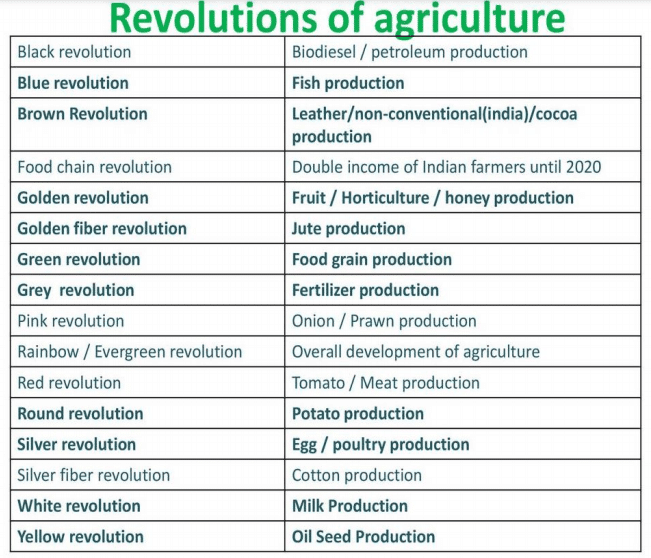

thank you so much sir for this very detailed and perfect information. its the best source, especially for a self studying aspirant.